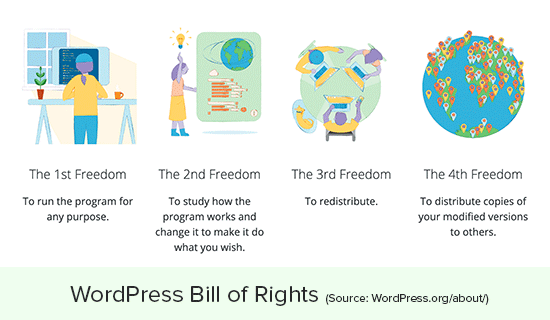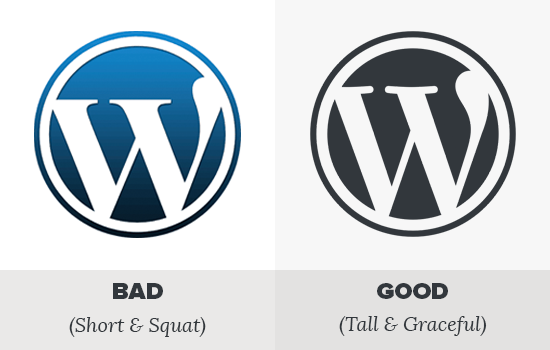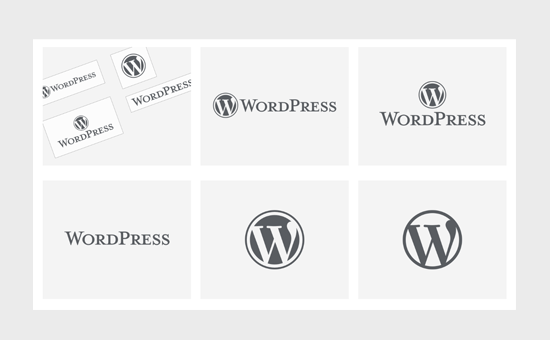4 “Must Know” Rules About WordPress Logo & Trademark (Explained) - MyHBD
June 20, 2020
As a user of WordPress and blogger writing about the platform, there are some rules about the WordPress logo and trademark that you need to keep in mind.
WordPress is open-source software, but it is still protected by copyright and trademark laws. Many beginners don’t know them, and they may accidentally violate the guidelines.
In this article, we will explain the rules you need to follow when using the WordPress logo and trademark. We will also discuss why it is important and what rights you are given under the WordPress license.
Understanding GPL – The WordPress License
Let’s start with the basics first.
There are two types of WordPress websites. First, there is WordPress.com which is a hosted solution, and then there is the popular WordPress.org also called self-hosted WordPress.
When most people say WordPress, they are talking about WordPress.org. To learn more see our guide on the difference between WordPress.com and WordPress.org.
WordPress is released under the open source GPL license. This makes WordPress a free software. However, free here is used as in freedom not as in free coffee.
This license gives anyone the freedom to download, copy, use, study, and modify the WordPress code.

While the software itself is free to use, you will need to purchase a domain name and web hosting account to install WordPress and make a website.
To learn more, see our article explaining why is WordPress free and what are the costs.
There is a misconception among beginners about free software and copyright. While you are free to use the software code in any way you want, the software itself is protected by copyright and trademark laws.
What does that mean?
Basically, you can copy the WordPress code to make new software, but you cannot call your software WordPress.
The name WordPress is a registered trademark owned by the WordPress foundation. It is a non-profit organization which ensures that WordPress runs successfully as a free open source project.
Why You Need to Understand WordPress Logo and Trademark Rules?
WordPress powers nearly 33% of all websites on the internet. That’s a really huge number.
Millions of businesses rely on WordPress to effectively run their website, online communities, and blogs.
To make sure that everything works smoothly, WordPress brand and trademark needed to be protected. For this purpose, the WordPress trademark was transferred to The WordPress Foundation in 2010.
Now the problem is that WordPress foundation is not the only one that works on WordPress. It is an open source project where thousands of people contribute to its success.
Apart from those contributors, there are many companies, individuals, and freelancers who sell WordPress related products and services around the world.
If you are running a WordPress website, a web design agency, or providing WordPress related services, then you need to understand these rules to comply with the trademark policies.
That being said, let’s take a look at the rules and guidelines that you must follow to properly use the WordPress trademark and logo in your projects.
Rule 1. Always Write WordPress with a Capital P
The correct way to spell WordPress is with a capital P. This capitalization is taken very seriously by the WordPress community.
If you are going to mention WordPress anywhere, then make sure that you use the correct spelling. Using an incorrect spelling is frowned upon and considered unprofessional.
WordPress team takes it so seriously that in 2010 they added a built-in filter called capital_P_dangit() in WordPress 3.0 release.
This function automatically corrects the misspelled instances of WordPress in title, content, and excerpts.
|
1
2
3
4
5
6
7
8
9
10
11
12
13
14
15
16
17
|
function capital_P_dangit( $text ) { // Simple replacement for titles $current_filter = current_filter(); if ( 'the_title' === $current_filter || 'wp_title' === $current_filter ) { return str_replace( 'Wordpress', 'WordPress', $text ); } // Still here? Use the more judicious replacement static $dblq = false; if ( false === $dblq ) { $dblq = _x( '“', 'opening curly double quote' ); } return str_replace( array( ' WordPress', '‘Wordpress', $dblq . 'Wordpress', '>Wordpress', '(WordPress' ), array( ' WordPress', '‘WordPress', $dblq . 'WordPress', '>WordPress', '(WordPress' ), $text );} |
Rule 2. Do not use WordPress in Your Domain Name
As we mentioned earlier that the name WordPress is a registered trademark owned by the WordPress foundation. This protects the WordPress brand and ensures its continued success.
Just like any other registered trademark, the WordPress Foundation reserves exclusive usage rights for the term WordPress. This means you cannot use WordPress as part of your brand name or website.
You can use WordPress in a subdomain such as (wordpress.example.com), the WordPress Foundation is mainly concerned about top-level domains.
If you see someone using WordPress in their domain name or brand name, then you should contact the WordPress Foundation and notify them about the violation.
See also: How to register a free domain name for your WordPress website.
Rule 3. The WordPress Logo
The WordPress logo consists of the letter W in a grey or sometimes white circle with a grey ring around it.
The height of the letter W is tall and graceful. Many bloggers and website owners sometimes mistakenly use the faux logo which usually has a shorter W in it.

Make sure that you are using the correct WordPress logo in your projects. The WordPress logo is also available as a text mark, text mark with W logo, and W logo.

You can download all these logos from the offical WordPress logos page.
Feel free to use these images in your projects. However, make sure that you use them in accordance with WordPress trademark policy.
Rule 4. No Affiliation or Endorsement
The WordPress foundation wants you to use the WordPress logo and brand to promote the WordPress project itself.
However, you are not allowed to use it in a way that suggests endorsement or affiliation with the project. Here are some examples:
- You cannot use WordPress logo in your product’s advertisements.
- You cannot use WordPress or its logo as part of your own logo.
- You can place ‘Powered by WordPress.org’ on your website, but you cannot say ‘Recommended by WordPress’.
In easier words, any attempts to take unfair advantage of WordPress brand name are a violation of the trademark policy.
What Happens When Someone Doesn’t Follow These Rules?
The WordPress foundation takes these violations very seriously. You may receive an email from them to comply with their trademark guidelines.
Failure to comply may lead to further actions. These actions may include several legal procedures.
For example, if you are using WordPress in your domain name, then foundation can claim that domain name. Their lawyers can also send you a legal notice.
The legal proceedings would cost you a lot of money, and you would lose support from the WordPress community itself.
The WordPress community relies on the WordPress foundation to take these actions. It benefits everyone in the ecosystem and helps countless WordPress related companies grow and succeed.
Sepehr Vaez Afshar
- Sepehr Vaez Afsharhttps://myhbd.net/author/sepehr/
- Sepehr Vaez Afsharhttps://myhbd.net/author/sepehr/
- Sepehr Vaez Afsharhttps://myhbd.net/author/sepehr/
- Sepehr Vaez Afsharhttps://myhbd.net/author/sepehr/
Categories
Recent Comments
-

-
 Install OpenConnect VPN Server (ocserv) on Ubuntu 20.04 with Let’s Encrypt October 17, 2022 2 Comments
Install OpenConnect VPN Server (ocserv) on Ubuntu 20.04 with Let’s Encrypt October 17, 2022 2 Comments -
